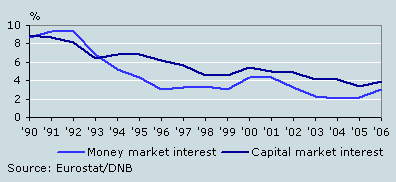Banks increase income from interest

Since the introduction of the euro for transferable money on 1 January 1999, Dutch banks have seen a strong growth in net interest margins through a favourable interest structure and a substantial increase in mortgages.
Net interest margins
Banks earn their money from the difference between the interest they pay to their account holders and the interest they receive on credit facilities. This net interest margin on loans and deposits constitutes the main part of the value added of banks. The other part consists of commission for financial services, such as mortgages and stock brokerage.
Net interest margin of banks

Substantial increase in interest margin 1999–2003
The net interest margin rose by more than 10 percent per year in the period 1999-2003. The increase was largest in 1999, a top year for the Dutch economy with GDP growth of nearly 5 percent, and in 2002, a trough year with zero growth. In these two years the amount the banks earned from the net interest margin rose by more than 15 percent. Interestingly in this respect, banks do not seem to be affected by business cycles developments.
Strong growth in margin on loans
The net interest margin depends on the difference between the interest rates on loans and deposits, i.e. the price effect, and the size of loans and deposits, i.e. the volume effect. Banks earned a lot on mortgages, business loans and consumer credit in particular in 1999-2003. In 1999 the size of bank loans increased substantially: by nearly 20 percent. In 2002 this increase was much smaller, at under 8 percent, but the difference between the interest rates rose considerably. Since 2003 there has been a noticeable slowdown in the increase of the interest margin.
Money and capital market interest in the Netherlands

Interest margin smaller in 2006
The money market interest rate was around 2 percent in 2004 and 2005. The capital market interest rate was already low in 2004 and fell further in 2005, putting the interest margin under pressure. At the end of 2005 the European Central Bank’s (ECB) main interest rate (the refinancing rate) was at a historical low. Since then the rate has been raised seven times to a level of 3.75 percent. The gradual increase by the ECB resulted in a strong increase in the money market interest rates in the eurozone and a further decrease of the interest margin in 2006.
Bram de Boo and Frederik Heinsius